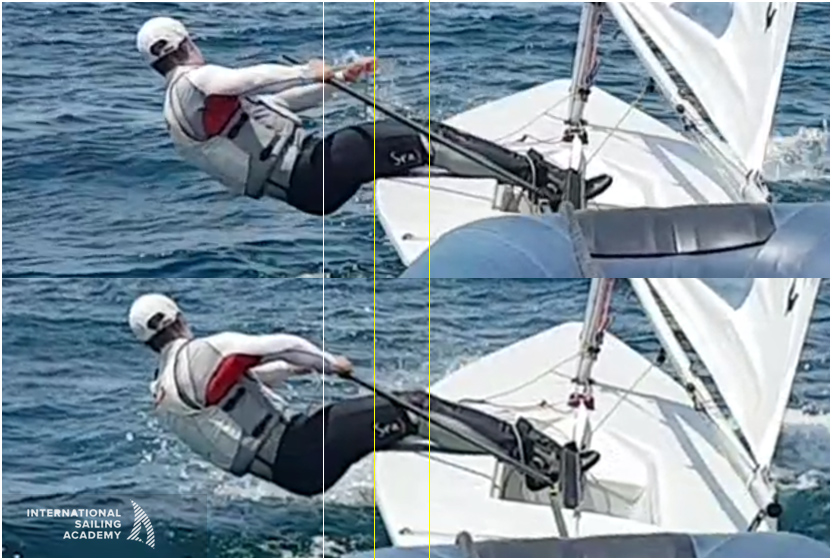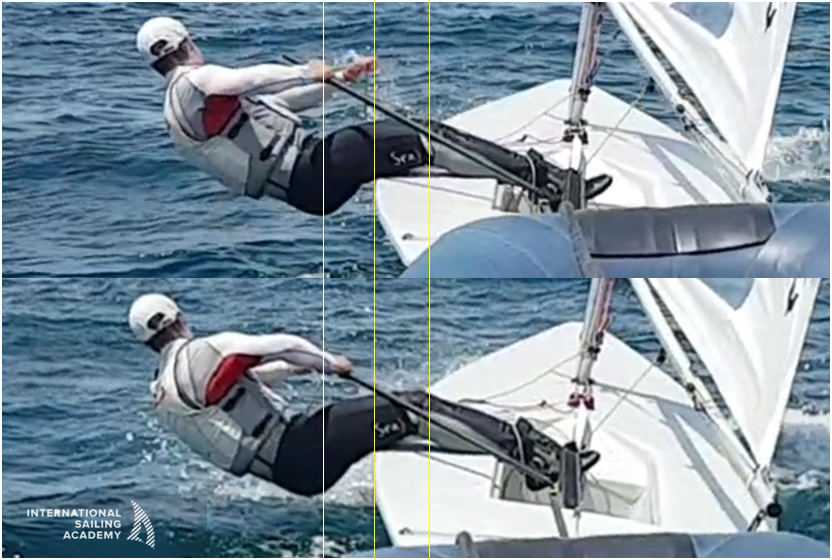Improve your upwind speed in the breeze by adjusting your body position to get the most out of your hiking. At our clinics, we provide the topmost laser sailing tips in which one of the first things we do is figure out how each sailor can tweak their hiking positioning and posture. The most important factor to hiking is not necessarily how low you can put your shoulders to the water, however that can be a strong contributing factor. But rather how close you can get your knees to the gunwale edge.
This is directly related to your righting moment. Yes, there’s plenty of technique, sail settings and fitness that can contribute to helping your average speed, but in windier conditions, people who're hiking position is better will have much less weather helm.

Without having to loosen his strap, the sailor slides out a couple of inches further onto his toes. We estimate 15-20 lbs of extra righting moment in the bottom photo.
Consider the edge of the boat as the fulcrum and your body as the lever arm producing effort, We can measure the effects of hiking as the force on the gunwale edge. It is maximized by shortening the distance and amount of bodyweight inside the cockpit and deck (Load), and increasing personal body mass on the opposite side of the fulcrum - over the water (Effort). This lever arm as a starting point should optimize and increase the pressure you would feel on your hiking pads as they connect to the boat.
For a 6 foot tall 180 pound individual every inch outboard equates to about 7 lbs of righting moment. There’s a bit of a 'Ah ha' moment when I tell the sailor, "that's what hiking is meant to feel like".
Very often we see sailors who can drop their shoulders and appear to be hiking hard. Except that their quadriceps muscles are hardly activated, rather they are only using their core muscles to maintain body erectness. While outlining the laser sailing tips, this is one of the first things we try to change. Once we determine the physiological restrictions, be it height, leg length, calf thickness and fitness we try to adjust the hiking strap to maximize the lever arm by basically attempting to get the knees as close as physically possible to the edge of the boat but without losing partial contact of the calves to the grab rails inside the cockpit.
Sometimes this requires a very loose hiking strap that can be pulled outboard with slight flexion in the ankles, with that you can gain an extra 1 to 3 inches of naval (center of body mass) further outboard. For a 6 foot tall 180 pound individual every inch outboard equates to about 7 lbs of righting moment. There’s a bit of an 'Ah-ha' moment when I tell the sailor, "that's what hiking is meant to feel like".

Without having to loosen his strap, the sailor slides out a couple of inches further onto his toes. We estimate 15-20 lbs of the extra righting moment in the bottom photo.
If the strap is too loose your calves will elevate too much, putting a lot of strain on your knees, and forcing unwanted hinging in the lower back. You need to have very good quadriceps, hip flexor, core and glute strength to keep your butt high enough from the water. This is something that needs to be built up as you strengthen those muscles to get used to the loads. Injury may occur if the strap is loosened too quickly and muscles are not strong enough.
Pro tip: in the lulls, shift your feet to the front of the hiking strap, near the main block to get a tighter setting and more connection. In bigger breeze shift aft toward the middle of the cockpit to have the looser strap setting, and hike off the widest part of the boat.
Tweaking hiking strap tensions can take years of experimentation. Within minutes we can diagnose your hiking weaknesses and make some pretty simple suggestions for how to adjust to your new settings.